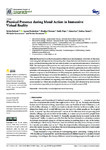Physical Presence during Moral Action in Immersive Virtual Reality
| dc.contributor.author | Terbeck, S | |
| dc.contributor.author | Charlesford, JJ | |
| dc.contributor.author | Clemans, H | |
| dc.contributor.author | Pope, E | |
| dc.contributor.author | Lee, A | |
| dc.contributor.author | Turner, J | |
| dc.contributor.author | Gummerum, M | |
| dc.contributor.author | Bussmann, B | |
| dc.date.accessioned | 2021-10-19T08:45:43Z | |
| dc.date.issued | 2021-07-29 | |
| dc.identifier.issn | 1660-4601 | |
| dc.identifier.issn | 1660-4601 | |
| dc.identifier.uri | http://hdl.handle.net/10026.1/18093 | |
| dc.description.abstract |
<jats:p>Research on morality has focused on differences in moral judgment and action. In this study, we investigated self-reported moral reasoning after a hypothetical moral dilemma was presented on paper, and moral reasoning after that very same dilemma was experienced in immersive virtual reality (IVR). We asked open-ended questions and used content analysis to determine moral reasoning in a sample of 107 participants. We found that participants referred significantly more often to abstract principles and consequences for themselves (i.e., it is against the law) after the paper-based moral dilemma compared to the IVR dilemma. In IVR participants significantly more often referred to the consequences for the people involved in the dilemma (i.e., not wanting to hurt that particular person). This supports the separate process theory, suggesting that decision and action might be different moral concepts with different foci regarding moral reasoning. Using simulated moral scenarios thus seems essential as it illustrates possible mechanisms of empathy and altruism being more relevant for moral actions especially given the physical presence of virtual humans in IVR.</jats:p> | |
| dc.format.extent | 8039-8039 | |
| dc.format.medium | Electronic | |
| dc.language | en | |
| dc.language.iso | en | |
| dc.publisher | MDPI | |
| dc.subject | moral judgments | |
| dc.subject | moral reasoning | |
| dc.subject | virtual reality | |
| dc.subject | Empathy | |
| dc.subject | Humans | |
| dc.subject | Judgment | |
| dc.subject | Morals | |
| dc.subject | Problem Solving | |
| dc.subject | Virtual Reality | |
| dc.title | Physical Presence during Moral Action in Immersive Virtual Reality | |
| dc.type | journal-article | |
| dc.type | Journal Article | |
| plymouth.author-url | https://www.ncbi.nlm.nih.gov/pubmed/34360328 | |
| plymouth.issue | 15 | |
| plymouth.volume | 18 | |
| plymouth.publication-status | Published online | |
| plymouth.journal | International Journal of Environmental Research and Public Health | |
| dc.identifier.doi | 10.3390/ijerph18158039 | |
| plymouth.organisational-group | /Plymouth | |
| plymouth.organisational-group | /Plymouth/Faculty of Health | |
| plymouth.organisational-group | /Plymouth/REF 2021 Researchers by UoA | |
| plymouth.organisational-group | /Plymouth/REF 2021 Researchers by UoA/UoA04 Psychology, Psychiatry and Neuroscience | |
| plymouth.organisational-group | /Plymouth/Users by role | |
| plymouth.organisational-group | /Plymouth/Users by role/Academics | |
| dc.publisher.place | Switzerland | |
| dcterms.dateAccepted | 2021-07-09 | |
| dc.rights.embargodate | 2021-10-20 | |
| dc.identifier.eissn | 1660-4601 | |
| dc.rights.embargoperiod | Not known | |
| rioxxterms.versionofrecord | 10.3390/ijerph18158039 | |
| rioxxterms.licenseref.uri | http://www.rioxx.net/licenses/all-rights-reserved | |
| rioxxterms.licenseref.startdate | 2021-07-29 | |
| rioxxterms.type | Journal Article/Review |


